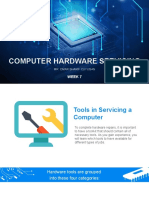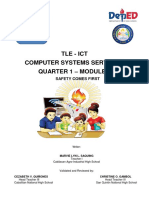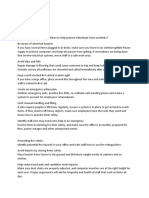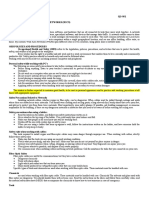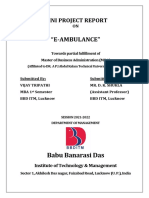0 ratings0% found this document useful (0 votes)
76 viewsEmbroidery Stitches
Embroidery Stitches
Uploaded by
Celeste D. BeringThis document provides information on common hazards encountered by computer technicians and users. It discusses physical hazards like tripping over cables, mechanical hazards like moving parts in printers that could injure hands, chemical hazards from cleaning products and toner, and electric shock hazards from working inside computers. It recommends 15 safety precautions like grounding yourself, not working alone, following manuals carefully, and knowing fire safety procedures.
Copyright:
© All Rights Reserved
Available Formats
Download as DOCX, PDF, TXT or read online from Scribd
Embroidery Stitches
Embroidery Stitches
Uploaded by
Celeste D. Bering0 ratings0% found this document useful (0 votes)
76 views9 pagesThis document provides information on common hazards encountered by computer technicians and users. It discusses physical hazards like tripping over cables, mechanical hazards like moving parts in printers that could injure hands, chemical hazards from cleaning products and toner, and electric shock hazards from working inside computers. It recommends 15 safety precautions like grounding yourself, not working alone, following manuals carefully, and knowing fire safety procedures.
Original Description:
embroidery stitches
Copyright
© © All Rights Reserved
Available Formats
DOCX, PDF, TXT or read online from Scribd
Share this document
Did you find this document useful?
Is this content inappropriate?
This document provides information on common hazards encountered by computer technicians and users. It discusses physical hazards like tripping over cables, mechanical hazards like moving parts in printers that could injure hands, chemical hazards from cleaning products and toner, and electric shock hazards from working inside computers. It recommends 15 safety precautions like grounding yourself, not working alone, following manuals carefully, and knowing fire safety procedures.
Copyright:
© All Rights Reserved
Available Formats
Download as DOCX, PDF, TXT or read online from Scribd
Download as docx, pdf, or txt
0 ratings0% found this document useful (0 votes)
76 views9 pagesEmbroidery Stitches
Embroidery Stitches
Uploaded by
Celeste D. BeringThis document provides information on common hazards encountered by computer technicians and users. It discusses physical hazards like tripping over cables, mechanical hazards like moving parts in printers that could injure hands, chemical hazards from cleaning products and toner, and electric shock hazards from working inside computers. It recommends 15 safety precautions like grounding yourself, not working alone, following manuals carefully, and knowing fire safety procedures.
Copyright:
© All Rights Reserved
Available Formats
Download as DOCX, PDF, TXT or read online from Scribd
Download as docx, pdf, or txt
You are on page 1of 9
EMBROIDERY STITCHES
1. Back stitch- the most often used to outline a design.
This stitch also forms the base line for other embroidery
stitches
2. Bullion stitch- a single detached stitch that is used
for filling in a design area. Rows of bullion stitches may
also be used to outline a design. It is recommended that
one uses a needle with a small eye for ease in pulling
3. Chain stitch- one of the more popular stitches used
for outlining. When worked in close rows, chain stitches
make good stitches for filling the design area.
4. Cross-stitch- stitched formed by two crossing arms
and may be used for outlining, as borders or to fill in an
entire area.
5. Feather stitch- a stitch with a loop and stitches
evenly worked on both left and right sides of a design
area.
6. Fish Bone- a kind of filling stitch which is ideal for
making leaves or feathers. It requires us to divide the
pattern into two and each side is filled alternately giving
it a plaited effect in the center, thus ideal to make leaves
or feathers.
7. French knot- a single detached stitched used
primarily to fill in a design area. It is a popular stitch
among embroiderers in that it can be used to create the
eyes on an embroidered face or the center of a flower.
8. Herringbone stitch- a basic overlapping stitch
popular for its use in borders.
9. Lazy daisy chain stitch- also called detached chain
stitch, this stitch is work in a circle to resemble the petals
of a flower.
10. Looped stitch- a very decorative stitch and can be
experimented with threads for various colors over
borders. Close layers of this stitch can create wonderful
effects on a pattern.
11. Running stitch- considered being the easiest stitch
for outlining.
12. Satin stitch- a solid filling stitch that is used to cover
a design area with long, straight stitches worked very
close together
13. Split stitch- done using quite thick threads, such as
wool. It was used as an outlining stitch or as a filling
stitch.
14. Seed stitch- also known as rice grain stitch. Stitch
uses simple straight stitches in a single direction to fill in
patterns. It has shorter stitches above the fabric and
longer stitches on the reverse side. They remind of
strawberry seeds, probably, which inspired its name.
15. Stem Stitch- basically an outline stitch, this stitch is
usually used for flower stems, and outlines. It can only
be used as filling, rows of Stem stitch worked closely
together within a shape until it is filled completely.
Lesson3: Occupational Health and Safety Procedures
HAZARD IDENTIFICATION,
RISK ASSESSMENT AND RISK CONTROL
Occupational safety and health (OSH) is a
planned system of working to prevent illness
and injury where you work by recognizing and
identifying hazards and risks.
THERE ARE THREE STEPS TO MANAGE
HEALTH AND SAFETY AT WORK
1. Spot the Hazard
A hazard is anything that could hurt you or
someone else.
Examples of workplace hazards include:
a. frayed electrical cords
b. boxes stacked precariously
c. noisy machinery
2. Assess the Risk
Assessing the risk means
working out how likely it is
that a hazard will harm
someone and how serious the harm could be.
Whenever you spot a hazard, assess the
risk by asking yourself two questions:
a. How likely is it that the hazard could harm
me or someone else?
b. How badly could I or someone else be
harmed?
For example,
(1)Ask your supervisor for instructions and
training before using equipment,
(2)Ask for help moving or lifting heavy
objects, and
(3) Tell your supervisor if you think a work
practice could be dangerous.
3. Make the Changes
It is your employer's responsibility to fix
hazards. Sometimes you may be able to fix
simple hazards yourself, as long as you don't
put yourself or others at risk.
For example, you can pick up things from
the floor and put them away to eliminate a trip
hazard.
Common hazards encountered by computer
technicians and users
A hazard is a situation in the workplace that has the
potential to harm the health and safety of people or to
damage plant and equipment. The situation could
involve a task, chemical or equipment used. Hazard
management is a continuous process that can be used
to improve the health and safety of all workplaces.
Physical Hazards
One of the most common physical hazards involving
computer technicians is cables running across the floor.
If someone trips, falls, and hurts himself because of a
cable you ran across the floor, someone (you, your
employer, or your customer) has a serious legal
negligence problem. If you need to temporarily run a
cable across the floor, place a Danger sign similar to
those "wet floor" signs used by cleaning services.
For cables that are temporary but will need to run across
the floor for a longer period of time, use "gaffers tape".
Gaffers tape is a heavy tape with strong adhesive to
stick to the floor. For long term cable routing there is a
wide variety of cable organizing devices like cable ties,
cable wraps, and cable raceways which can be used to
run cable safely along the wall or ceiling.
ICT- COMPUTER HARDWARE SERVICING
38
Other common physical hazards include leaving tools
on top of ladders and placing electronic equipment in
precarious positions or on support that is not sturdy
enough or not designed for holding electronic
equipment.
Mechanical Hazards
When working on electronic equipment, ask yourself "Is
there any way this equipment could hurt me?” You might
stick your hand in a printer and suddenly the paper feed
arm moves, feeding not only paper through the printer,
but a piece of your finger too.
You might move your hand past a computer chassis and
lose a chunk of flesh because it is razor sharp. When
working on electronic equipment always be alert to any
possibility of being hurt by moving parts, hot
components, or sharp edges.
Chemical Hazards
There is a wide array of chemicals used with electronic
equipment. There are display cleaning chemicals,
keyboard cleaning chemicals, compressed gas dirt and
dust removers, and many cleaning solvents. Some of
these chemicals can be harmful if accidentally
swallowed, get on bare skin, or get in eyes. Before using
any chemicals for electronic equipment always read the
warnings and instructions on the label.
Also be very careful when dealing with inkjet printer
cartridges, or laser printer toner cartridges. Ink and
toner can stain skin, clothing and carpet.
Electric Shock Hazard
Inside computers and electronic equipment, there is a
range of voltages from 3.3 volts to 25 volts, most of
which are harmless. But at the power supply, you will
find line voltage, which is a lethal 220 volts.
The workplace should have safety guidelines to follow
to:
Protect people from injury
Protect equipment from damage
Protect the environment from contamination
Safety Precautions when working:
1. Always ground or discharge yourself before touching
any part of the computer.
2. Do not work alone so that there is someone who can
take care of you in case of accident or emergency.
3. Be careful with the tools that may cause short circuit.
4. Always full the cable connector on the handle and not
hold on the cable itself.
ICT- COMPUTER HARDWARE SERVICING
39
5. Use only rubber shoes when standing on the ground
or in a concrete floor.
6. Make sure that the pins are properly aligned when
connecting a cable connector.
7. Always power off and unplug the computer before
working on it.
8. Take away any liquid such as mineral water or soft
drinks near your working area
or near computers.
9. Contingency measures during workplace accidents,
fire, and other emergencies
are recognized.
10. Personal protective equipment is correctly used in
accordance with organization
procedures and practice.
11. Hazard/risks in the workplace and their
corresponding indicators are identified to
minimize or eliminate risk to co‐workers, workplace, and
environment.
12. Take necessary precautions to protect the
component of the computer from
damaged caused by Electrostatic Discharge (ESD).
13. Hold the components by edges and do not touch the
IC’s.
14. Read and follow instructions on the manual
carefully.
15. Do not use excessive force if things do not quite slip
into place.
Fire Safety Guidelines
Know the location of fire extinguishers, how to use
them and which to use for electrical fires and for
combustible fires.
Find an escape route in case a fire gets out of
control.
Know how to contact emergency services quickly
Keep the workspace clean.
Keep most solvents in a separate area.
You might also like
- Important Government and Public Sector Organisations of India For SSC Railway ExamsDocument17 pagesImportant Government and Public Sector Organisations of India For SSC Railway Examsramesh100% (2)
- BEAUTY - NAIL CARE NC II Module 1 - Final PDFDocument30 pagesBEAUTY - NAIL CARE NC II Module 1 - Final PDFCeleste D. Bering100% (15)
- Governing System (210 MW, LMW Machines)Document16 pagesGoverning System (210 MW, LMW Machines)Ashish Subramanian100% (4)
- High-Performance Condenser Tube Cleaning System Featuring Advanced Ball Collecting Technology - r2005 - 03 - 104 PDFDocument5 pagesHigh-Performance Condenser Tube Cleaning System Featuring Advanced Ball Collecting Technology - r2005 - 03 - 104 PDFnur hamzahNo ratings yet
- Css Grade 10 q4 Lesson3 PDocument17 pagesCss Grade 10 q4 Lesson3 PJennilyn A. DavidNo ratings yet
- Occupational Health and Safety Procedure GRADE 10 Q1Document5 pagesOccupational Health and Safety Procedure GRADE 10 Q1sarahcalago2009No ratings yet
- Lesson-4-OHSDocument3 pagesLesson-4-OHSthryxiahopelumbaNo ratings yet
- Lesson 1.3Document3 pagesLesson 1.3Otoy KatsuNo ratings yet
- NT 1.1 OhsDocument7 pagesNT 1.1 OhsMeianne MarfaNo ratings yet
- Sim Grade 8Document7 pagesSim Grade 8Lorbie Castañeda FrigillanoNo ratings yet
- TLE ICT 7 Module 3Document4 pagesTLE ICT 7 Module 3cid ladjamatliNo ratings yet
- Css For Grade 7&8 - FQL1 - BC4 - 1. Identify Hazard and Risk - LMS - 2021 - 2022Document14 pagesCss For Grade 7&8 - FQL1 - BC4 - 1. Identify Hazard and Risk - LMS - 2021 - 2022Nemino Catulay RickyNo ratings yet
- First Quarter-Module 1Document9 pagesFirst Quarter-Module 1Princess Loraine DuyagNo ratings yet
- Quarter-1 Module-1 G10 CSSDocument12 pagesQuarter-1 Module-1 G10 CSSRhonalyn Angel GalanoNo ratings yet
- Tle 7 OhsDocument26 pagesTle 7 OhsFrance PilapilNo ratings yet
- Lesson - Chap 1Document23 pagesLesson - Chap 1Marciel ArcinueNo ratings yet
- Module 5-Occupational Health and Safety ProceduresDocument7 pagesModule 5-Occupational Health and Safety ProceduresJelie PanganNo ratings yet
- CHS - Set3 - W7-9 FinalDocument112 pagesCHS - Set3 - W7-9 FinalOmar Sharif CuyuganNo ratings yet
- LESSON 2 - G9 Occupational Health and Safety ProceduresDocument28 pagesLESSON 2 - G9 Occupational Health and Safety ProceduresEm Zee Aromaz100% (1)
- Hazard Identification, Risk Assessment, and RiskDocument19 pagesHazard Identification, Risk Assessment, and RiskAndiebou SalamedaNo ratings yet
- Las Grade 12 CSS 2Document2 pagesLas Grade 12 CSS 2Jenelyn RusianaNo ratings yet
- CHS Set3 W7-9Document99 pagesCHS Set3 W7-9Omar Sharif CuyuganNo ratings yet
- Lesson 7 - Occupational Health and Safety Policies and ProceduresDocument5 pagesLesson 7 - Occupational Health and Safety Policies and ProceduresDyck Andre RoblesNo ratings yet
- Occupational Health and Safety ProceduresDocument15 pagesOccupational Health and Safety Proceduresmarlon felizardo100% (1)
- Occupational Health and Safety ProceduresDocument15 pagesOccupational Health and Safety Proceduresmarlon felizardoNo ratings yet
- Lesson 4Document18 pagesLesson 4Jessa Mae RoneNo ratings yet
- Ict - CSS 10Document18 pagesIct - CSS 10Puche MaraNo ratings yet
- Quarter 1 Module 1 G10 CSS Cabilaoan Agro Industrial HS 1Document12 pagesQuarter 1 Module 1 G10 CSS Cabilaoan Agro Industrial HS 1Alyssa SantosNo ratings yet
- ICT GRADE 8.3 Occupational Safety and HealthDocument3 pagesICT GRADE 8.3 Occupational Safety and HealthKevin Dela CalzadaNo ratings yet
- Task 9 Health and SafteyDocument2 pagesTask 9 Health and SafteyAaron CarlisleNo ratings yet
- TLECSS Grade10 QTR1 Module1-RevalidatedDocument20 pagesTLECSS Grade10 QTR1 Module1-RevalidatedLiam PitchanNo ratings yet
- OHS Policies and ProceduresDocument9 pagesOHS Policies and Proceduresjuvan05No ratings yet
- EGALLA Lec AssignmentDocument5 pagesEGALLA Lec AssignmentDerek C. EgallaNo ratings yet
- Computer Systems Servicing NCII Quarter 2 Week 1Document9 pagesComputer Systems Servicing NCII Quarter 2 Week 1R TECHNo ratings yet
- Task Sheet CSS OHSDocument8 pagesTask Sheet CSS OHSVicente Negre100% (1)
- TLE 10 Week 2 - Use of Hand Tools and Equipment in ComputerDocument24 pagesTLE 10 Week 2 - Use of Hand Tools and Equipment in ComputerJohn King johnking.monderinNo ratings yet
- Activity Sheet Week7 7Document2 pagesActivity Sheet Week7 7William Vincent SoriaNo ratings yet
- Technology and Livelihood EducationDocument11 pagesTechnology and Livelihood EducationLendrei QuerimitNo ratings yet
- Computerhardwareservicing-Lesson 4Document23 pagesComputerhardwareservicing-Lesson 4Guilmar Terrence RamirezNo ratings yet
- Aristotle 3rdweek1Document3 pagesAristotle 3rdweek1Corazon LayaNo ratings yet
- Inglés - 11° Grado-Electrónica - Ii Parcial, I SemestreDocument15 pagesInglés - 11° Grado-Electrónica - Ii Parcial, I SemestreAngel CruzNo ratings yet
- ICT ContactCenterServices 9 Q1 LAS3 FINALDocument10 pagesICT ContactCenterServices 9 Q1 LAS3 FINALjnp021105No ratings yet
- AssignmentsDocument4 pagesAssignmentsrumsfeldzindogaNo ratings yet
- Identify Hazards and RisksDocument29 pagesIdentify Hazards and RisksAnonymous xU8piENo ratings yet
- Part B UNIT 4 NOTESDocument6 pagesPart B UNIT 4 NOTESPREETHINo ratings yet
- Safe Working PracticesDocument7 pagesSafe Working PracticesDiana ParkerNo ratings yet
- Hazard Identification, Risk Assessment and Risk Control Occupational Safety and Health (OSH) Is A Planned SystemDocument13 pagesHazard Identification, Risk Assessment and Risk Control Occupational Safety and Health (OSH) Is A Planned SystemHydralyn PalchanNo ratings yet
- Grade 10 - Week1 OHS Policies and ProceduresDocument2 pagesGrade 10 - Week1 OHS Policies and ProceduresPurificacion, AnabeaNo ratings yet
- Module 1 and 3Document12 pagesModule 1 and 3CABADONGA, Justin M.No ratings yet
- Occupational Health and SafetyDocument12 pagesOccupational Health and SafetyJudylyn SalunaNo ratings yet
- CSS - Week 1 - UHTDocument97 pagesCSS - Week 1 - UHTLeny Malabanan De SagunNo ratings yet
- Lec1 Occupational Health and Safety ProceduresDocument14 pagesLec1 Occupational Health and Safety ProceduresVivencio Pascual JrNo ratings yet
- 1.-Edited CSS8 Q1w1 10pgs Franco SPTVEDocument10 pages1.-Edited CSS8 Q1w1 10pgs Franco SPTVExiaolagac5No ratings yet
- css-9 Module Q3-Week-1-4Document23 pagescss-9 Module Q3-Week-1-4Sonia Manalon AgustinNo ratings yet
- CSS - Week 1 - UHTDocument95 pagesCSS - Week 1 - UHTJes RonaNo ratings yet
- TLE Grade7 8 Module2 Quarter1 Week1Document5 pagesTLE Grade7 8 Module2 Quarter1 Week1Genie ManzanoNo ratings yet
- Activity 1 11Document2 pagesActivity 1 11elinito.vivaNo ratings yet
- Lesson 1 PRACTICE OCCUPATIONAL HEALTH AND SAFETY PROCEDURESDocument7 pagesLesson 1 PRACTICE OCCUPATIONAL HEALTH AND SAFETY PROCEDURESKrizaleih QuiñonesNo ratings yet
- TLE Grade8 ICT-CSS Module2 Quarter1 Week1Document9 pagesTLE Grade8 ICT-CSS Module2 Quarter1 Week1Hazel Mae EbaritaNo ratings yet
- Inglés - 11° Grado-ElectricidadDocument13 pagesInglés - 11° Grado-ElectricidadhgrasapapuNo ratings yet
- UNIT 1-LESSON 1 - Occupational Health and Safety PDFDocument4 pagesUNIT 1-LESSON 1 - Occupational Health and Safety PDFDarwin RamosNo ratings yet
- Lesson 7 in TLE 7Document6 pagesLesson 7 in TLE 7Leo Nino DulceNo ratings yet
- Basic Cabinet Making for Beginners Guide: A Step by Step Manual with Techniques, Tools, Hints and Simple Furniture Construction ProjectsFrom EverandBasic Cabinet Making for Beginners Guide: A Step by Step Manual with Techniques, Tools, Hints and Simple Furniture Construction ProjectsNo ratings yet
- Ohs in IctDocument23 pagesOhs in IctCeleste D. BeringNo ratings yet
- Handicraft in The PhilippinesDocument8 pagesHandicraft in The PhilippinesCeleste D. BeringNo ratings yet
- Safety Precautions When Working in The Computer LaboratoryDocument29 pagesSafety Precautions When Working in The Computer LaboratoryCeleste D. BeringNo ratings yet
- Final Pre Test Grade 10 HairdressingDocument5 pagesFinal Pre Test Grade 10 HairdressingCeleste D. Bering100% (2)
- HANDICRAFT EXPLORATORY ExamDocument5 pagesHANDICRAFT EXPLORATORY ExamCeleste D. BeringNo ratings yet
- Materials in OrigamiDocument14 pagesMaterials in OrigamiCeleste D. Bering100% (2)
- Performance Evaluation SheetDocument2 pagesPerformance Evaluation SheetCeleste D. BeringNo ratings yet
- TLE/TVL - HE (Handicraft) : J/ShsDocument14 pagesTLE/TVL - HE (Handicraft) : J/ShsCeleste D. Bering100% (1)
- 8 HandiDocument44 pages8 HandiCeleste D. BeringNo ratings yet
- Embroidery Tools and Its UsesDocument2 pagesEmbroidery Tools and Its UsesCeleste D. BeringNo ratings yet
- Development of Philippine EmbroideryDocument31 pagesDevelopment of Philippine EmbroideryCeleste D. Bering100% (5)
- Interactive DiagramDocument1 pageInteractive DiagramCeleste D. BeringNo ratings yet
- KnittingDocument3 pagesKnittingCeleste D. BeringNo ratings yet
- Commissioner Luis R. Asis National High SchoolDocument3 pagesCommissioner Luis R. Asis National High SchoolCeleste D. Bering100% (1)
- DepEd Order No3 S. 2018 PDFDocument26 pagesDepEd Order No3 S. 2018 PDFCeleste D. BeringNo ratings yet
- Perform Mensuration and CalculationDocument8 pagesPerform Mensuration and CalculationCeleste D. BeringNo ratings yet
- Commissioner Luis R. Asis National High SchoolDocument1 pageCommissioner Luis R. Asis National High SchoolCeleste D. BeringNo ratings yet
- By: Mona Marie Bergantinos 10 - OrchidDocument7 pagesBy: Mona Marie Bergantinos 10 - OrchidCeleste D. Bering100% (1)
- Needle Nose Pliers,: Wire CutterDocument1 pageNeedle Nose Pliers,: Wire CutterCeleste D. BeringNo ratings yet
- Development of Philippine EmbroideryDocument28 pagesDevelopment of Philippine EmbroideryCeleste D. Bering100% (1)
- Entrepreneurship 9Document19 pagesEntrepreneurship 9Celeste D. Bering33% (3)
- Lesson 1.safety GuidelinesDocument8 pagesLesson 1.safety GuidelinesCeleste D. BeringNo ratings yet
- Torx Screw Driver,: Wire CutterDocument1 pageTorx Screw Driver,: Wire CutterCeleste D. BeringNo ratings yet
- Problems-Selected Problems in TacheometryDocument2 pagesProblems-Selected Problems in TacheometryaboodNo ratings yet
- D 153Document31 pagesD 153marcoNo ratings yet
- Simulation of 2.4Ghz Microstrip Patch Antenna Using Ebg StructureDocument5 pagesSimulation of 2.4Ghz Microstrip Patch Antenna Using Ebg StructureSanjeev KumarNo ratings yet
- Cargador de BatieraDocument30 pagesCargador de BatieraCARLO DÍAZNo ratings yet
- Power Xpert 9395 UPS 300 kVA Installation and Operation ManualDocument134 pagesPower Xpert 9395 UPS 300 kVA Installation and Operation ManualtarawutNo ratings yet
- Reference, Sense and Denotation in English SemanticsDocument2 pagesReference, Sense and Denotation in English Semanticsomarrabeaa1234No ratings yet
- Using The Kinor 16 CX-2MDocument28 pagesUsing The Kinor 16 CX-2MseanlivingstondavisNo ratings yet
- Activity 1 Serial Dilution NEWDocument7 pagesActivity 1 Serial Dilution NEWJoshua Richard Jr Tubiano Payopanin100% (1)
- Organization Chart of TOYOTADocument1 pageOrganization Chart of TOYOTASella JaisNo ratings yet
- ISCM China Co., Ltd. WCA Member DetailsDocument5 pagesISCM China Co., Ltd. WCA Member DetailsSiddhesh GawandeNo ratings yet
- Slide LayoutsDocument4 pagesSlide LayoutsDef GopNo ratings yet
- Epmun Usa UnscDocument2 pagesEpmun Usa UnscAdhiswaraNo ratings yet
- Calculus 2024Document66 pagesCalculus 2024davidmajutla87No ratings yet
- Lab-2: Introduction To Labview (Part-2) : 1. ObjectiveDocument13 pagesLab-2: Introduction To Labview (Part-2) : 1. ObjectiveAsad RazaNo ratings yet
- ATL CatalogDocument40 pagesATL CatalogFranciscoNo ratings yet
- Lifting of Answers From The Internet Is Considered ZeroDocument14 pagesLifting of Answers From The Internet Is Considered ZeroBelinda Viernes100% (1)
- Learning Packages Versus Conventional Methods of Instruction PDFDocument114 pagesLearning Packages Versus Conventional Methods of Instruction PDFReynan VenusNo ratings yet
- Wind Load As Per IS875 Part 3-2015Document10 pagesWind Load As Per IS875 Part 3-2015hobuneyNo ratings yet
- Gujarat Maritime Board v. Larsen & Toubro Infrastructure Development Projects LTD., (2016) 10 SCC 46Document10 pagesGujarat Maritime Board v. Larsen & Toubro Infrastructure Development Projects LTD., (2016) 10 SCC 46ishika.chauhanNo ratings yet
- DNV AuditDocument2 pagesDNV AuditDimitris NikouNo ratings yet
- Invoice BV35158708Document2 pagesInvoice BV35158708Nabil AlashwalNo ratings yet
- E Ambulance 1Document45 pagesE Ambulance 1Chandan Srivastava100% (1)
- TT Ni 217 Ic 59 31Document2 pagesTT Ni 217 Ic 59 31Kayph Ul Islam SiddiquiNo ratings yet
- AnyTone AT-779 OperatingDocument1 pageAnyTone AT-779 OperatingDavid BrownNo ratings yet
- Overview of Current Parapsychology Research in The Former Soviet UnionDocument23 pagesOverview of Current Parapsychology Research in The Former Soviet UnionRonald Alvarez VeraNo ratings yet
- ENGLISH Language I - Topic 5 - Future TensesDocument31 pagesENGLISH Language I - Topic 5 - Future TensesSandra VNo ratings yet
- "A Study On Challenges Faced by Indian Banking System DuringDocument48 pages"A Study On Challenges Faced by Indian Banking System DuringPriti DuttaNo ratings yet





















